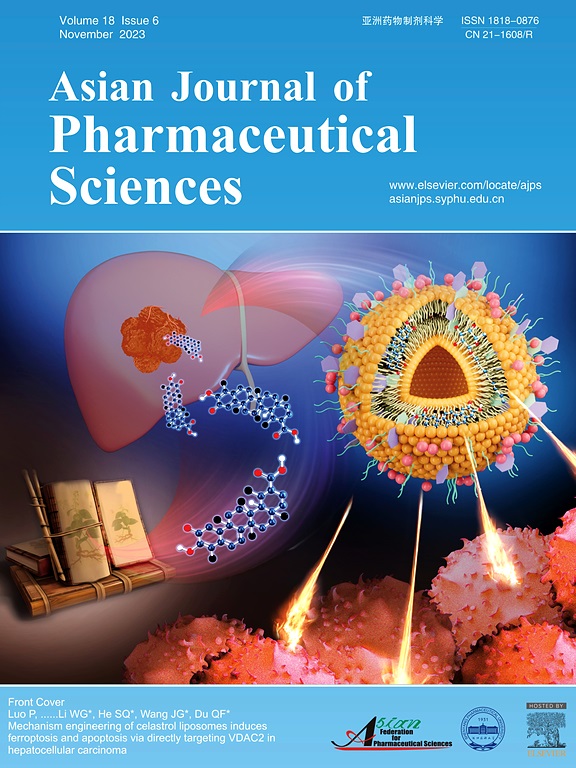Enhanced lymphatic transportation of SLN by mimicking oligopeptide transportation route
IF 11.9
1区 医学
Q1 PHARMACOLOGY & PHARMACY
引用次数: 0
Abstract
Solid lipid nanoparticles (SLN) could enhance the oral bioavailability of loaded protein and peptide drugs through lymphatic transport. Natural oligopeptides regulate nearly all vital processes and serve as a nitrogen source for nourishment. They are mainly transported by oligopeptide transporter-1 (PepT-1) which are primarily expressed in the intestine with the characteristics of high-capacity and low energy consumption. Our preliminary research discovered the transmembrane transport of SLN could be improved by stimulating the oligopeptide absorption pathway. This implied the potential of combining the advantages of SLN with oligopeptide transporter mediated transportation. Herein, two kinds of dipeptide modified SLN were designed with insulin and glucagon like peptide-1 (GLP-1) analogue exenatide as model drugs. These drugs loaded SLN showed enhanced oral bioavailability and hypoglycemic effect in both type I diabetic C57BL/6 mice and type II diabetic KKAy mice. Compared with un-modified SLN, dipeptide-modified SLN could be internalized by intestinal epithelial cells via PepT-1-mediated endocytosis with higher uptake. Interestingly, after internalization, more SLN could access the systemic circulation via lymphatic transport pathway, highlighting the potential to combine the oligopeptide-absorption route with SLN for oral drug delivery.

通过模拟寡肽运输途径增强SLN的淋巴运输
固体脂质纳米颗粒(SLN)可通过淋巴运输提高载蛋白和多肽药物的口服生物利用度。天然寡肽调节几乎所有的生命过程,并作为营养的氮源。它们主要通过寡肽转运体-1 (PepT-1)运输,主要在肠道内表达,具有高容量、低能耗的特点。我们的初步研究发现,通过刺激寡肽吸收途径可以改善SLN的跨膜转运。这意味着将SLN的优势与寡肽转运体介导的转运结合起来的潜力。本实验以胰岛素和胰高血糖素样肽-1 (GLP-1)类似物艾塞那肽为模型药物,设计了两种二肽修饰的SLN。这些药物负载SLN在I型糖尿病小鼠C57BL/6和II型糖尿病小鼠KKAy中均表现出增强的口服生物利用度和降糖作用。与未修饰的SLN相比,二肽修饰的SLN可以通过pept -1介导的内吞作用被肠上皮细胞内化,并且摄取更高。有趣的是,内化后,更多的SLN可以通过淋巴运输途径进入体循环,这突出了将寡肽吸收途径与SLN结合用于口服给药的潜力。
本文章由计算机程序翻译,如有差异,请以英文原文为准。
求助全文
约1分钟内获得全文
求助全文
来源期刊

Asian Journal of Pharmaceutical Sciences
Pharmacology, Toxicology and Pharmaceutics-Pharmaceutical Science
CiteScore
18.30
自引率
2.90%
发文量
11
审稿时长
14 days
期刊介绍:
The Asian Journal of Pharmaceutical Sciences (AJPS) serves as the official journal of the Asian Federation for Pharmaceutical Sciences (AFPS). Recognized by the Science Citation Index Expanded (SCIE), AJPS offers a platform for the reporting of advancements, production methodologies, technologies, initiatives, and the practical application of scientific knowledge in the field of pharmaceutics. The journal covers a wide range of topics including but not limited to controlled drug release systems, drug targeting, physical pharmacy, pharmacodynamics, pharmacokinetics, pharmacogenomics, biopharmaceutics, drug and prodrug design, pharmaceutical analysis, drug stability, quality control, pharmaceutical engineering, and material sciences.
 求助内容:
求助内容: 应助结果提醒方式:
应助结果提醒方式:


